#Factories
Text



...
-L.F.
290 notes
·
View notes
Text








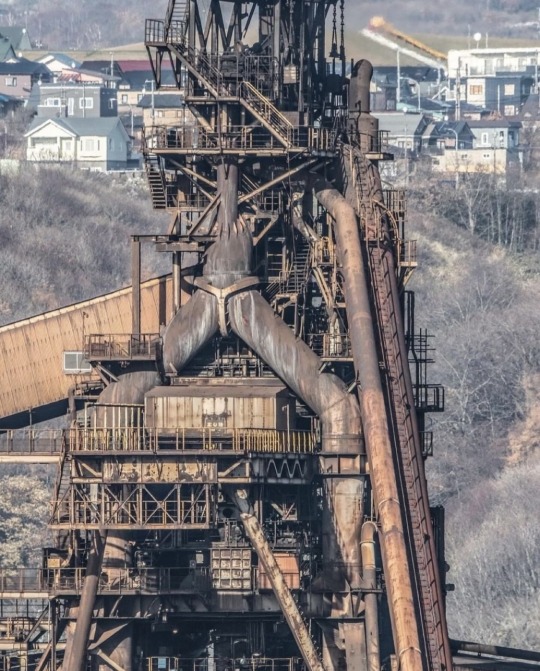

Factories in Japan ph. Tetsurou Kobayashi
#factories#🏭#japan#metalcore#grungecore#dystopia#dystopic#sadcore#architecture#metal#places#techcore#industrial
157 notes
·
View notes
Text
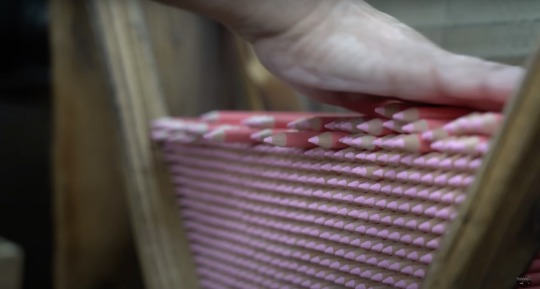
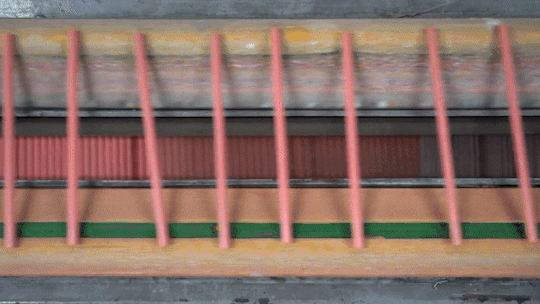

We’ve Got It Made: Process X Goes Behind the Scenes to Demystify the Production of Our Favorite Objects and Tools
276 notes
·
View notes
Text
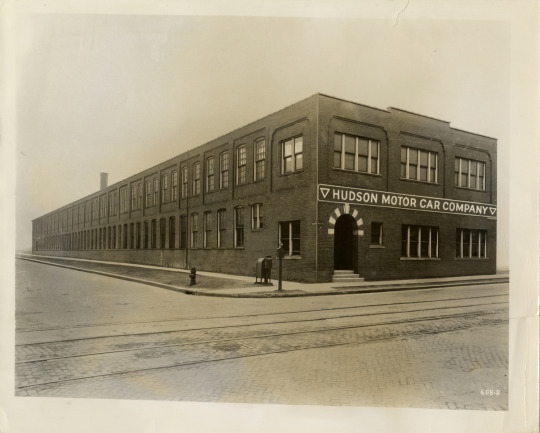
View of the first Hudson Motor Car Company factory. Label on back: "First Hudson plant. This is the first factory operated by the Hudson Motor Car Company. It was located at the corner of Mack and Beaufait Avenues. In this plant with only 80,000 feet of floor space, 500 men, and a total capital of $20,000, the first Hudson "Twenty" was produced on July 3, 1909. One year later over 4,000 Hudson "Twenties" had been sold, the biggest first year's business in the history of the industry up to that time." Handwritten on back: "1909 Hudson factory. Factories--Hudson."
National Automotive History Collection, Detroit Public Library
#80000#folllowers#hudson motor car company#hudson#detroit#detroit history#1909#factory#factories#detroit public library
40 notes
·
View notes
Text

Manufacturing spiral puttees at plant of Alexander Propper & Company, New York City. Preparing the puttees for bailing. [African-American women working.]
Record Group 165: Records of the War Department General and Special Staffs Series: American Unofficial Collection of World War I Photographs
This black and white photograph shows eight women standing at sewing machines in a large factory. The women wear the long skirts of 1918 and some wear white caps on the their heads. Fabric is piled up next to each sewing machine. The women stand in pairs working next to a glass wall. Through the glass, other people can be seen looking over to the women.
50 notes
·
View notes
Photo

Tesla Factories: A Scale Comparison - January 2024 Update
by u/brandude87
37 notes
·
View notes
Text
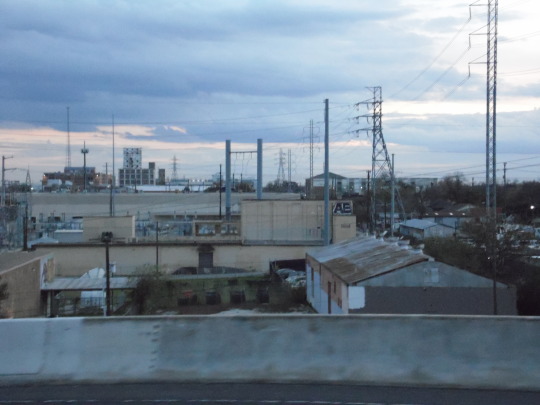

#mine#photo#industrial#americana#dusk#urban#factories#digital#photography#photographers on tumblr#city#texas#blur#♡
50 notes
·
View notes
Text
"Fix my head, it's pouring at the seams.
All the voices scream to a crescendo
In the garden by the sycamore tree
Lies a thousand horrifying memories.
I feel the unbearable weight.
I sense the ripping of my shame.
I feel the sigh of indifference."
-Autoheart
#autoheart#shameless#opening#opening up#factories#love songs#inspiring quotes#depressing quotes#ptsd quote#complex ptsd#ptsd#ptsd recovery#actually ptsd#post traumatic stress disorder#music#lyrics#lyric posting
10 notes
·
View notes
Text
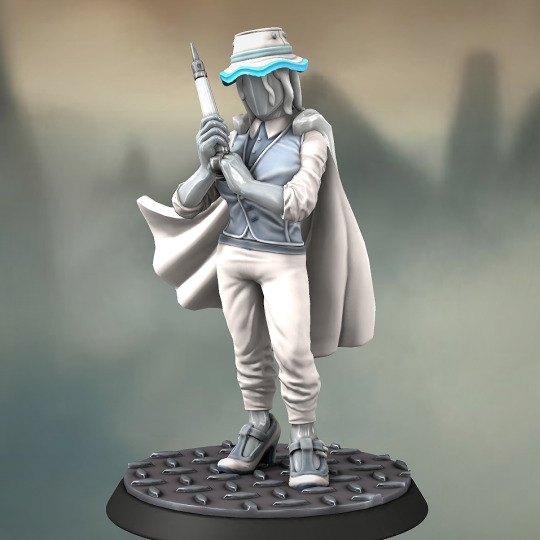

Nihilego injects a mind-controlling drug into its victims bodies and takes advantage of them for dark deeds. Its victims vary from the powerful to the frail, and there is no pattern to predict who will be the next.
Race: Living Doll
Class: Artificer
Subclass: Fleshsmith Specialist
Location: Oak's Laboratory
Alignment: Lawful Evil
View the pokedex of all dungeon pokemon by following the link in the menu.
#Nihilego#Living Doll#Artificer#Fleshsmith Specialist#Lawful Evil#factories#underworld#pokemon#dnd pokemon#pokemon dnd#fan art#dnd#dungeons and dragons#hero forge#hero forge minis
30 notes
·
View notes
Text

Mill District, Pittsburgh (Jack Delano, 1940)
#vintage photography#black and white photography#bw photography#old photo#pittsburgh pennsylvania#rust belt#steel mill#working class#factories#1940s
60 notes
·
View notes
Text




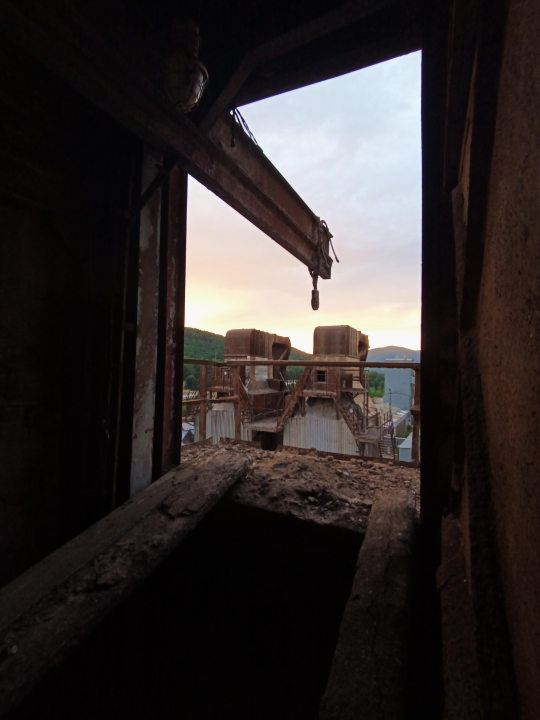
...
-L.F.
#photography#my photography#urbex#urban exploration#abandoned places#factories#industrial#magnesite#phone camera
334 notes
·
View notes
Text
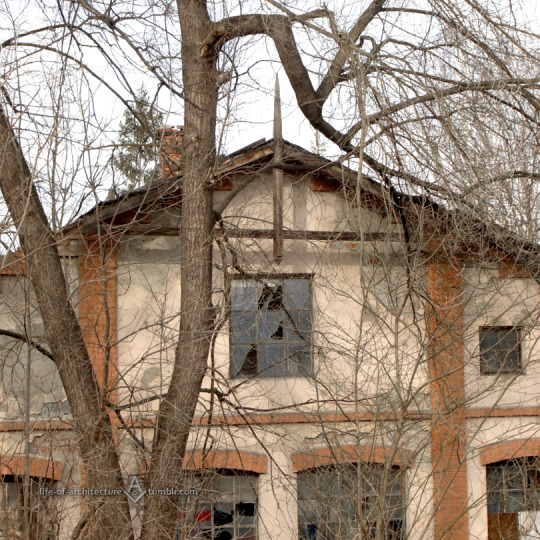

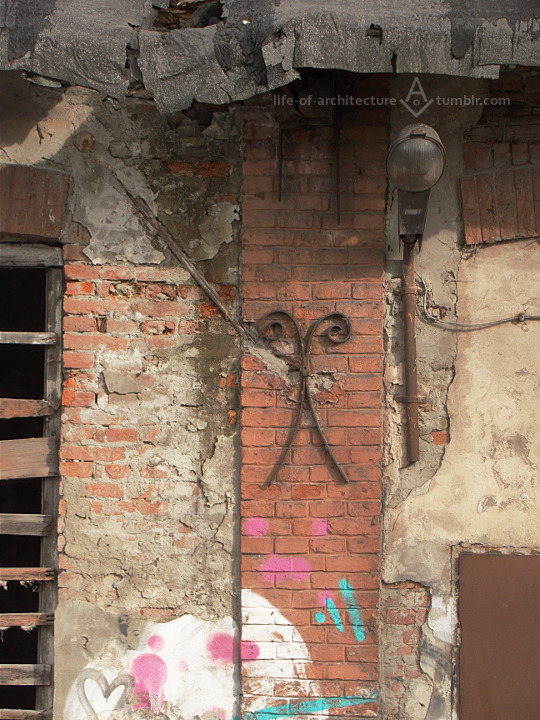
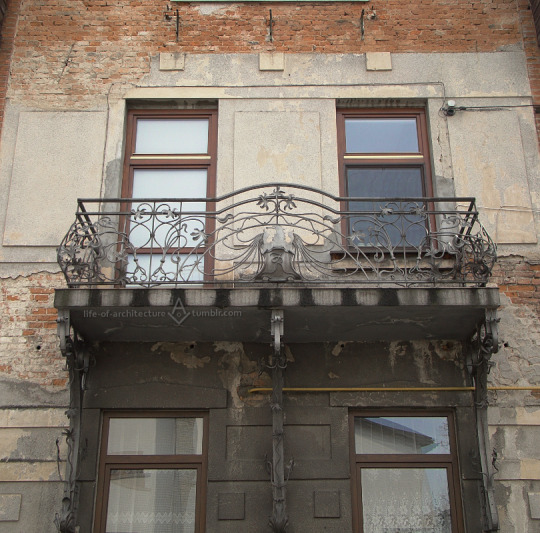

Nowy Sącz
ul. Fabryczna
foto z 16 lutego 2020
Na trzech pierwszych zdjęciach południowy szczyt, resztki dachu i ankier na ścianie hali fabrycznej z 1906 r. Należała do Józefa Rossmanitha, który otworzył tu swoje przedsiębiorstwo najpierw pod nazwą Odlewarni Żelaza, Stali i Metalów, a rozszerzywszy działalność, z czasem przemianował na Fabrykę Maszyn, Wyrobów i Konstrukcyi Żelaznych. Maszyny fabryczne napędzał nurt Młynówki, nieistniejącego dziś sztucznego strumienia zasilanego wodą pobliskiej rzeki Kamienicy. Koło wodne fabryki miało moc 42 koni mechanicznych.
Na dwóch ostatnich zdjęciach frontowa elewacja stojącego obok fabryki domu Rossmanithów z lat 1912-1914 r. projektu Zenona Adama Remiego, z kutą balustradą balkonową, prezentującą możliwości firmy.
Małżeństwo Rossmanithów. Urodzony w czeskiej Opawie, w spolonizowanej rodzinie niemieckiej, Józef poślubił Etelkę Adelajdę von Bartfai z węgierskiej rodziny Grünwaldów, z Bardejowa. Stąd w domu z kutym balkonem mówiono wtedy głównie po węgiersku.

Załoga fabryki w drugiej dekadzie XX w. Pośrodku widoczna prawdopodobnie Maria Maak, główna księgowa, a po śmierci Józefa Rossmanitha w 1914 r. kierowniczka firmy. W latach świetności, w fabryce pracowało 60 robotników. W 1920 r. zastrajkowali, czym wywalczyli sobie ośmiogodzinny dzień pracy.

Ogłoszenia reklamowe firmy z 1906…
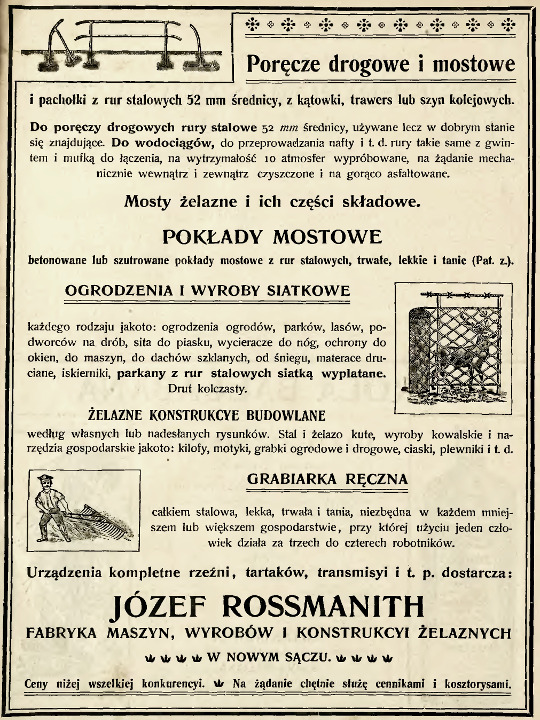
…i 1912 r.

><><><><><><><><><><><><><><><
Nowy Sącz, Poland
Fabryczna Street
taken on 16 February 2020
First three photos show the southern facade, remains of the roof and an anchor plate on the wall of a factory hall built in 1906 r. It was a property of Józef Rossmanith who started his business here first as Iron, Steel and Metals Foundry and after diversifying the production renamed it Factory of Machines, Iron Products and Constructions. The factory equipment was powered by a waterwheel generating 42 hp thanks to nonexistent today Młynówka, an artificial stream supplied by the nearby Kamienica river.
Two latter photos show the front facade of the nearby Rossmaniths house from 1912-1914, designed by Zenon Adam Remi. The wrought iron balcony used to present the factory's abilities.
[the married Rossmanith couple]
Józef, born in Opava in a family of polonised Germans, married Etelka Adelajda von Bartfai née Grünwald, a Hungarian from Bardejov. Hence the default language of their household behind the iron balcony was Hungarian.
[the factory crew in 1910s]
In the center is most likely Maria Maak, the main accountant and after Józef Rossmanith's death in 1914 also the main manager. In the prime years up to 60 people used to work there. In 1920 they went on a strike that ended succesfully with an agreement for the 8h workday.
[the Rossmanith factory's ads from 1906]
[and 1912]
#historical facts#factories#industrial architecture#labour history#vintage ads#photographers on tumblr#original photography#Central Europe#Eastern Europe#Poland#Polska#Nowy Sącz#Nowy Sacz#balconies#wrought iron#eagles in art#retro#local history#family business#early capitalism
10 notes
·
View notes
Photo
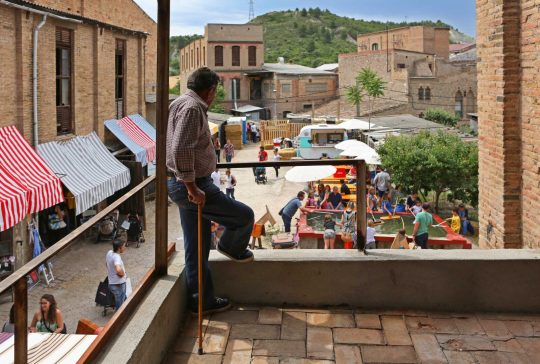
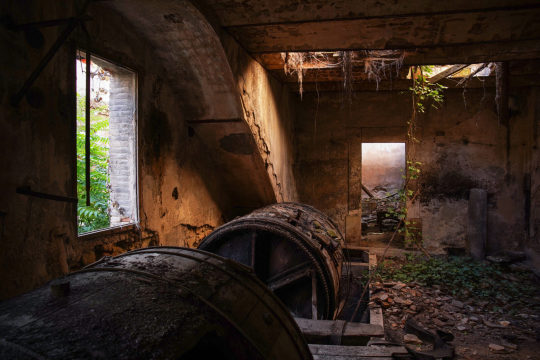

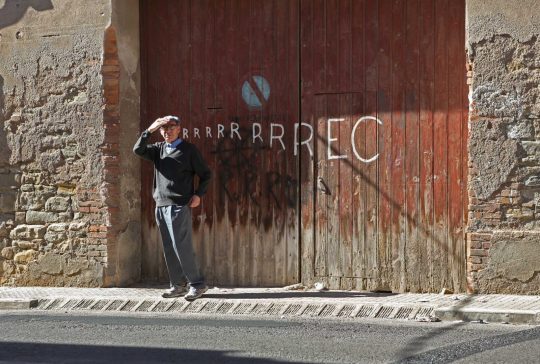

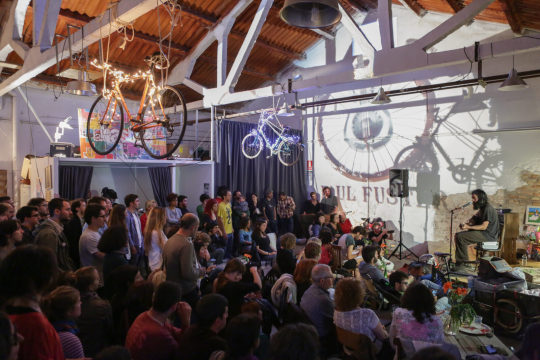




Rec en transformació (“Rec in transformation”) by photographer Marc Vila, virtual exhibition on Museu de la Pell d’Igualada i Comarcal de l’Anoia (more photos in the link).
I have been lucky to live in first person the transformation of the Rec district, to see the tanneries where it looked like time had stopped since they shut down, and the transformation of these empty spaces into spaces full of life, working as a photographer for Rec.0 and also on a personal level collaborating with La Bastida del Rec.
He tingut la sort de viure en primera persona la transformació del barri del Rec, de poder veure adoberies on semblava que s’havia aturat el temps des que van tancar la porta i la transformació d’aquests espais buits en espais plens de vida, treballant com a fotògraf per Rec.0 i també a nivell més personal col·laborant amb La Bastida del Rec.
Rec is an industrial district of the city of Igualada (Central Catalonia). Most of its buildings date back to the industrial revolution and were used as tanneries and factories.
Over the last few decades, several institutions and local entities, academics, neighbours and activists have promoted the district’s rediscovery and made citizens aware of the need to protect extremely valuable architectural heritage that explains, like no other, the outstanding past and present of an enterprising city. Since then, the unceasing recovery of the heritage of old, unused factories has begun to fill them with life through new activities.
#igualada#catalunya#catalonia#fotografia#industrial heritage#industrial#industrial revolution#factories#city#cities#europe#travel#urban#urban photography#cityscape#solarpunk#reusability#reuse#creative reuse#photojournalism
68 notes
·
View notes
Text
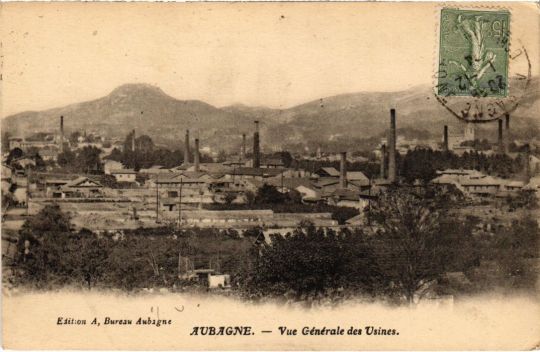
View of the Factories of Aubagne, Provence region of southern France
French vintage postcard, mailed in 1924
#factories#aubagne#historic#1924#photo#briefkaart#vintage#region#provence#southern#sepia#photography#carte postale#postcard#mailed#postkarte#france#postal#tarjeta#ansichtskarte#french#old#view#ephemera#postkaart
9 notes
·
View notes
Text
Okay so I have a question that I’ve wondering about for a while now, because I know the Peaky fandom has people from all around the world in it. How do you watch it, like how does it come across etc, when you’re from a completely different culture or area to where the series is set?
For example: I live in a different country, but I do live in a small town where everyone used to work in the old factories up until only a few decades ago. So, very industrialised and you can see the old factories everywhere. It’s also in the countryside and people are relatively poor here, and mainly working class. So, quite a bit of similarities with Small Heath, especially how it used to be. But, times are different now obviously. Also, I am part Romani and grew up travelling, everyone had horses etc, which makes me look at it all very differently too I suppose…
Please tell me what it’s like for you? Anything you recognise or not at all? Or very different? I just want to know what it’s like basically for you when you watch it.
#does this make sense?#just curious#please tell me!#peaky blinders#history#culture#working class#factories#poverty
18 notes
·
View notes